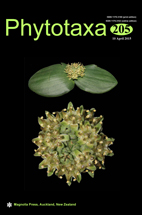Abstract
The family Botryosphaeriaceae encompasses important plant-associated pathogens, endophytes and saprobes with a wide geographical and host distribution. Two dark-spored botryosphaeriaceous taxa associated with Rhus typhina dieback and canker disease were collected from Ningxia Province, in northwestern China. Morphology and multigene analysis (ITS, LSU and EF-1α) clearly distinguished this clade as a distinct species in the genus. Phaeobotryon rhois is introduced and illustrated as a new species in this paper. The species is characterized by its globose, unilocular fruiting bodies and small, brown, 1-septate conidia. It can be distinguished from the similar species P. cercidis, P. cupressi, P. mamane and P. quercicola based on host association and conidial size and colour.

